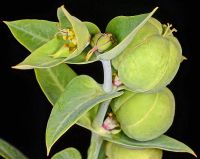Distribution: Occurring chiefly west of the Cascades crest in Washington; British Columbia to California east to Idaho, Montana, Arizona, and Texas; widely distributed in eastern North America.
Habitat: Disturbed soil and wasteland.
Flowers: April-May
Origin: Introduced from Eurasia
Growth Duration: Annual
Conservation Status: Not of concern
Pollination: Bees, wasps
Glabrous and glaucous annual, the stems erect, fleshy, dichotomously branched, 3-10 dm. tall.
Leaves opposite, numerous, narrowly oblong, 6-12 cm. long and sessile near the stem base; leaves broadened upward on the stem, becoming ovate.
Flowers tiny, monoecious, borne in axillary involucres; staminate flowers numerous, naked, each consisting of a single stamen; pistillate flower single and terminal in the involucre; involucre about 3 mm. long, purplish, bearing 4 glands with short, rounded horns.
Capsule globose, coarsely wrinkled, 5-10 mm. long, separating into three 1-seeded segments.
Publication: Sp. Pl. 1: 457. 1753.
PNW Herbaria: Specimen records of Euphorbia lathyris in the Consortium of Pacific Northwest Herbaria database
WA Flora Checklist: Euphorbia lathyris checklist entry
OregonFlora: Euphorbia lathyris information
E-Flora BC: Euphorbia lathyris atlas page
CalPhotos: Euphorbia lathyris photos










































